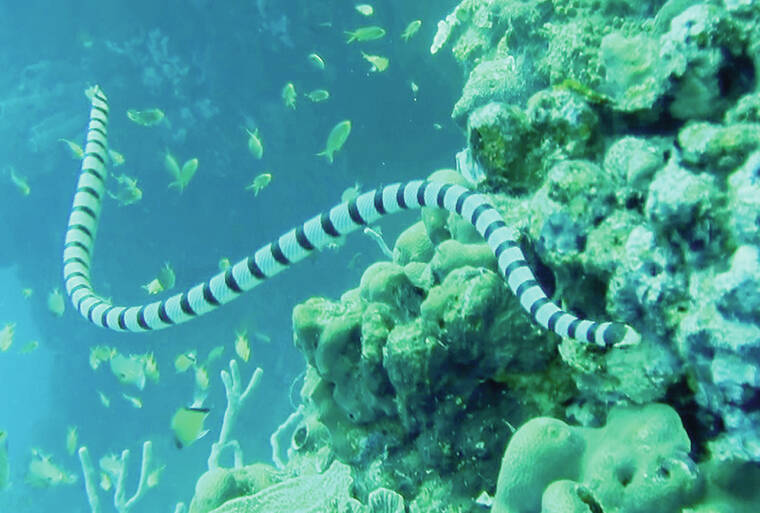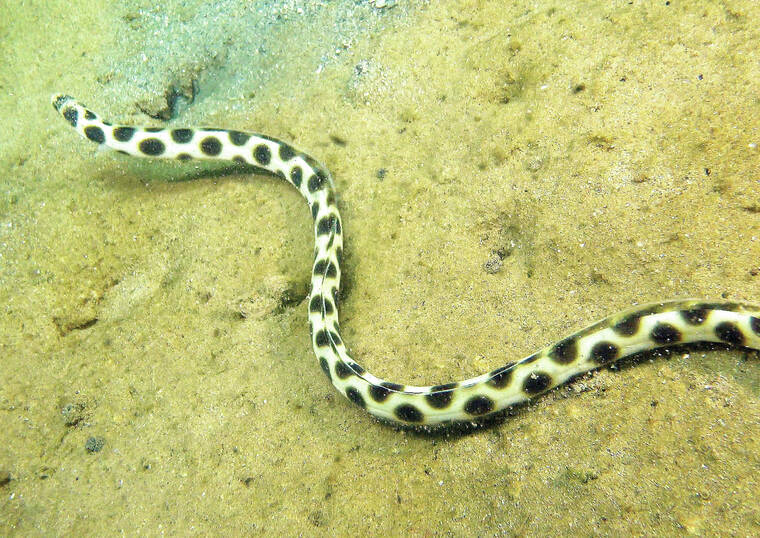It was a beautiful calm day for a scuba dive, and we took off with six divers aboard our small dive boat. About 100 yards offshore, we dropped down into clear warm water at 40 feet deep right into the middle of six large, highly venomous sea snakes that were getting ready to breed.
What a thrill for me, as I love snakes. I had a captive breeding snake research center for 20 years in California, so to scuba dive and video sea snake breeding was very special. Don’t worry about your next dive in Hawai‘i, as our sea snake dive was in the Philippines.
We do have sea snakes in Hawai‘i from time to time that drift in on the currents, but we have a type of eel that looks very similar to a sea snake. Sea snakes are reptiles and they need to breathe air. So when you see one on the bottom within a 30 minute period of time, the snake will swim to the surface to breathe.
Sea snakes grow to about three feet long and are covered in shiny scales and their tongue is always moving in and out of its mouth so it can smell the small fish it feeds on underwater. The snake uses its toxic venom to kill the fish that it swallows whole, and as a general rule sea snakes do not bother or attack us divers so they are safe to view underwater as long as you don’t get in their way when they are feeding. Sea snakes mate in the water, but lay their eggs on land, much like a sea turtle does.
In Hawai‘i, we have several species of snake eels that look very similar to sea snakes. These 2-foot long eels swim very much like a sea snake, but since they are a fish they can breathe underwater. They crawl along the seafloor in search of small fish to eat just like the sea snakes do, but they never go up to the surface or out onto the beach. The snake eels live much of their lives down in holes in the reef or under the sand, so they may be quite common divers rarely see them. I often have a diver in Hawai‘i tell me that they saw a sea snake, but actually it was a snake eel.
If you are diving in Hawai‘i or the Philippines there is an easy way to tell the difference between a venomous sea snake and a harmless snake eel.
Sea snakes do not have fins and they have a flat paddle-like tail for swimming whereas the snake eel has a long fin all the way down its back.
You can identify a snake eel even if you can only see an inch of its body by looking for their dorsal fin. Many fish and snake species have the same patterns and colors and those may change from country to country and even reef to reef, so color patterns are not normally used to identify marine life. Looking at the body shape and fin structure is the best way to figure out what you are looking at while diving.
You can see the sea snakes in action in my movie about the marine life of Apo Island in the Philippines up on my YouTube channel at Underwater2web and I will be coming out with a full sea snake movie soon. If you sign up on the channel you will get all my new movies first as soon as they are released.
•••
Terry Lilley is a marine biologist living in Hanalei Kaua‘i and co-founder of Reef Guardians Hawai‘i, a nonprofit on a mission to provide education and resources to protect the coral reef. To donate to Reef Guardians Hawaii go to www.reefguardianshawaii.org.






